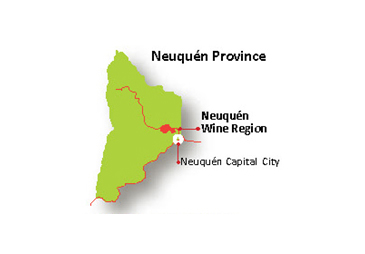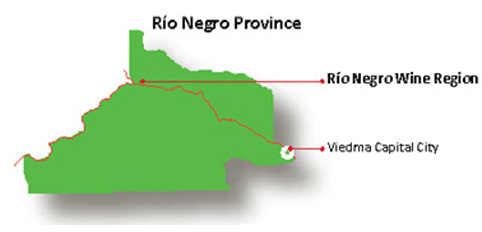Patagonia encompasses the extreme south of the American continent, mostly in Argentina, and represents more than a third of the land mass of Argentina. Argentine Patagonia consists of many provinces (states) among which Neuquén and Río Negro are located at the northern edge of Patagonia. Neuquén borders the province of Mendoza (Argentina’s primary wine region) directly to the south along the Andes Mountain Range. Río Negro is to the east and south of Neuquén extending all the way to the Atlantic Ocean.
The wine regions of Patagonia are located in Neuquén and Río Negro, and La Pampa. The vineyards are clustered primarily in the areas where the two provinces come together in their north, far from the Andes Mountains, and where the two rivers of Limay and Neuquén merge to become the Río Negro. Different from the Mendoza and Salta Wine Regions, the Patagonia Wine Region is far away from the Andes Mountains at a much lower elevation of 850’. Being far away from the Andes, this region does not get snow, nor the devastating effects of summer hail. When you see leaf damage in the vineyard, this is from the intense winds.
THE Neuquén (Patagonia) Wine Region

Neuquén, the capital city of the Neuquén province, is central to the Patagonia Wine Region, also the largest city in both provinces of Neuquén and Río Negro. With its size and fast growth, comes many things to do and see in and around the downtown area. There are some fantastic restaurants too. And, downtown Neuquén is a beautiful walking community. Tree-lined streets with extra large walking areas, parks, shops, restaurants, art galleries, museums, and an active night life.
The world’s newest wine region has recently been born in Neuquén! Not that long ago, at the turn of the century, the concept of a brand-new wine region was realized by planting 5,000 acres of Patagonia desert with grapevines into a terroir that would produce exclusively top-quality, premium wines. Today, there are five wineries producing more wine than the rest of Patagonia combined. All five wineries are located on the north side of Río Neuquén, 37 miles northwest of the city of Neuquén, next to the small village of San Patricio del Chañar, on Ruta 7. The wineries are all practically next to each other, making them easy to visit.
THE Río Negro (Patagonia) Wine Region

Río Negro is the world’s southernmost wine region. Río Negro is both a province (to the east and south of Neuquén) and a grand river which flows from Neuquén 310 miles to the Atlantic Ocean, creating three agricultural regions in its route. The Río Negro river is formed at the convergence of the Río Neuquén and Río Limay (at Neuquén city near the Neuquén wine region), and is divided into Alto Valle (high valley) at the beginning of the river, Valle Medio (middle valley) near Choele Choel, and Valle Inferior (lower valley) at the end of the river where it flows into the Atlantic Ocean.
Alto Valle is the most prosperous part of the province with the predominance of the pear and apple plantations, plus most of the wineries and vineyards are here as the General Roca Appellation of Río Negro. Ruta 22 runs though the middle of this valley, giving easy access to all the wineries. Being the cooler Patagonia climate, elegant styles of Pinot Noir, Sauvignon Blanc, Merlot, and Malbec are the primary wines produced here.
The Río Negro Alto Valle is 12 miles wide with the Río Negro river flowing along the southern edge of the valley, and the main canal runs along the north. In between are the numerous vineyards and orchards, with Ruta 22 connecting the cities and town of this wine region. For Argentina, the 800’ elevation on the valley floor here is unusually low for vineyards of the typical high elevations along the Andes Mountains. General Roca is centrally located in the valley, and it is the largest town (population 86,000), offering an ideal location for your hotel stay.


